R P3C-D
Dual Pentium® III / II Motherboard
USER’S MANUAL
�
USER'S NOTICE
No part of this manual, including the products and software described in it, may be repro-
duced, transmitted, transcribed, stored in a retrieval system, or translated into any language in
any form or by any means, except documentation kept by the purchaser for backup purposes,
without the express written permission of ASUSTeK COMPUTER INC. (“ASUS”).
ASUS PROVIDES THIS MANUAL “AS IS” WITHOUT WARRANTY OF ANY KIND,
EITHER EXPRESS OR IMPLIED, INCLUDING BUT NOT LIMITED TO THE IMPLIED
WARRANTIES OR CONDITIONS OF MERCHANTABILITY OR FITNESS FOR A PAR-
TICULAR PURPOSE. IN NO EVENT SHALL ASUS, ITS DIRECTORS, OFFICERS,
EMPLOYEES OR AGENTS BE LIABLE FOR ANY INDIRECT, SPECIAL, INCIDEN-
TAL, OR CONSEQUENTIAL DAMAGES (INCLUDING DAMAGES FOR LOSS OF
PROFITS, LOSS OF BUSINESS, LOSS OF USE OR DATA, INTERRUPTION OF BUSI-
NESS AND THE LIKE), EVEN IF ASUS HAS BEEN ADVISED OF THE POSSIBILITY
OF SUCH DAMAGES ARISING FROM ANY DEFECT OR ERROR IN THIS MANUAL
OR PRODUCT.
Product warranty or service will not be extended if: (1) the product is repaired, modified or
altered, unless such repair, modification of alteration is authorized in writing by ASUS; or (2)
the serial number of the product is defaced or missing.
Products and corporate names appearing in this manual may or may not be registered trade-
marks or copyrights of their respective companies, and are used only for identification or
explanation and to the owners’ benefit, without intent to infringe.
• Adobe and Acrobat are registered trademarks of Adobe Systems Incorporated.
• Crystal, SoundFusion, CrystalWave are trademarks of Cirrus Logic, Inc.
• Intel, LANDesk, and Pentium are registered trademarks of Intel Corporation.
• Rambus, Direct Rambus, and RIMM are trademarks of Rambus Inc.
• Windows and MS-DOS are registered trademarks of Microsoft Corporation.
• Trend and ChipAwayVirus are trademarks of Trend Micro, Inc.
The product name and revision number are both printed on the product itself. Manual revi-
sions are released for each product design represented by the digit before and after the period
of the manual revision number. Manual updates are represented by the third digit in the manual
revision number.
For previous or updated manuals, BIOS, drivers, or product release information, contact ASUS
at http://www.asus.com.tw or through any of the means indicated on the following page.
SPECIFICATIONS AND INFORMATION CONTAINED IN THIS MANUAL ARE FUR-
NISHED FOR INFORMATIONAL USE ONLY, AND ARE SUBJECT TO CHANGE AT
ANY TIME WITHOUT NOTICE, AND SHOULD NOT BE CONSTRUED AS A COM-
MITMENT BY ASUS. ASUS ASSUMES NO RESPONSIBILITY OR LIABILITY FOR
ANY ERRORS OR INACCURACIES THAT MAY APPEAR IN THIS MANUAL, INCLUD-
ING THE PRODUCTS AND SOFTWARE DESCRIBED IN IT.
Copyright © 1999 ASUSTeK COMPUTER INC. All Rights Reserved.
ASUS P3C-D
Product Name:
Manual Revision: 1.12 E445
Release Date:
December 1999
2
ASUS P3C-D User’s Manual
�
ASUS CONTACT INFORMATION
ASUSTeK COMPUTER INC. (Asia-Pacific)
Marketing
Address:
Telephone:
Fax:
Email:
150 Li-Te Road, Peitou, Taipei, Taiwan 112
+886-2-2894-3447
+886-2-2894-3449
info@asus.com.tw
Technical Support
MB/Others (Tel):
+886-2-2890-7121 (English)
Notebook (Tel):
+886-2-2890-7122 (English)
Desktop/Server (Tel):+886-2-2890-7123 (English)
Fax:
Email:
WWW:
FTP:
+886-2-2895-9254
tsd@asus.com.tw
www.asus.com.tw
ftp.asus.com.tw/pub/ASUS
ASUS COMPUTER INTERNATIONAL (America)
Marketing
Address:
6737 Mowry Avenue, Mowry Business Center, Building 2
Newark, CA 94560, USA
+1-510-608-4555
tmd1@asus.com
Fax:
Email:
Technical Support
Fax:
BBS:
Email:
WWW:
FTP:
+1-510-608-4555
+1-510-739-3774
tsd@asus.com
www.asus.com
ftp.asus.com/Pub/ASUS
ASUS COMPUTER GmbH (Europe)
Marketing
Address:
Fax:
Email:
Harkortstr. 25, 40880 Ratingen, BRD, Germany
+49-2102-442066
sales@asuscom.de (for marketing requests only)
Technical Support
Hotline:
Fax:
Support (Email):
WWW:
FTP:
MB/Others: +49-2102-9599-0 Notebook: +49-2102-9599-10
+49-2102-9599-11
www.asuscom.de/de/support (for online support)
www.asuscom.de
ftp.asuscom.de/pub/ASUSCOM
ASUS P3C-D User’s Manual
3
�
CONTENTS
1. INTRODUCTION ............................................................................. 7
1.1 How This Manual Is Organized .................................................. 7
1.2 Item Checklist ............................................................................. 7
2. FEATURES ........................................................................................ 8
2.1 The ASUS P3C-D ....................................................................... 8
2.1.1 Specifications .................................................................. 8
2.1.2 Specifications–Optional Components ............................. 9
2.1.3 Performance ................................................................... 10
2.1.4 Intelligence .................................................................... 11
2.2 Motherboard Parts ..................................................................... 12
3. HARDWARE SETUP ...................................................................... 14
3.1 Motherboard Layout ................................................................. 14
3.2 Layout Contents ........................................................................ 15
3.3 Hardware Setup Procedure ....................................................... 17
3.4 Motherboard Settings ................................................................ 17
3.5 System Memory ........................................................................ 22
3.5.1 Installing Memory Using RIMM ................................... 24
3.5.2 Installing Memory Using an ASUS DIMM Riser ......... 25
3.6 Central Processing Unit (CPU) ................................................. 29
3.6.1 Quick CPU Installation Procedure ................................ 29
3.6.2 Attaching the Heatsink .................................................. 30
3.6.3 Installing the Universal Retention Mechanism ............. 30
3.6.4 Installing the Processor .................................................. 32
3.6.5 Removing the Processor ................................................ 33
3.6.6 Recommended Heatsinks for Slot 1 Processors ............ 33
3.6.7 Precautions .................................................................... 34
3.7. Expansion Cards ........................................................................ 35
3.7.1 Expansion Card Installation Procedure ......................... 35
3.7.2 Assigning IRQs for Expansion Cards ............................ 36
3.7.3 Accelerated Graphics Port (AGP) Pro ........................... 37
3.8 External Connectors .................................................................. 38
3.9 Power Connection Procedures .................................................. 49
4. BIOS SETUP ..................................................................................... 50
4.1 Managing and Updating Your BIOS ......................................... 50
4.1.1 Upon First Use of the Computer System ....................... 50
4.1.2 Updating BIOS Procedures ........................................... 51
4.1.2 Managing and Updating Your BIOS ............................. 52
4
ASUS P3C-D User’s Manual
�
CONTENTS
4.2 BIOS Setup Program ................................................................ 53
4.2.1 BIOS Menu Bar ............................................................. 54
4.2.2 Legend Bar .................................................................... 54
4.3 Main Menu ................................................................................ 56
4.3.1 Primary & Secondary Master/Slave .............................. 57
4.4 Advanced Menu ........................................................................ 62
4.4.1 CHIP Configuration ....................................................... 64
4.4.2 I/O Device Configuration .............................................. 67
4.4.3 PCI Configuration ......................................................... 69
4.4.4 Shadow Configuration ................................................... 71
4.5 Power Menu .............................................................................. 72
4.5.1 Power Up Control .......................................................... 74
4.5.2 Hardware Monitor ......................................................... 76
4.6 Boot Menu ................................................................................ 77
4.7 Exit Menu ................................................................................. 79
5. SOFTWARE SETUP ....................................................................... 81
5.1 Operating Systems .................................................................... 81
5.1.1 Windows 98 First Time Installation .............................. 81
5.2 P3C Series Motherboard Support CD ....................................... 82
5.3 Intel LDCM Administrator Setup ............................................. 84
5.4 Intel LDCM Client Setup .......................................................... 86
5.5 INF Update Utility for Intel 820 Chipset .................................. 88
5.6 Install Crystal SoundFusion Audio
Driver (VxD) (only with onboard audio option)....................... 89
5.7 Install Crystal SoundFusion Audio
Driver (WDM) (only with onboard audio option) .................... 90
5.8 Install CrystalWave Synthesizer
(only with onboard audio option) ............................................. 91
5.9 Install ASUS PC Probe Vx.xx .................................................. 92
5.10 Install ASUS Update Vx.xx ...................................................... 93
5.11 Install PC-Cillin 98 Vx.xx ........................................................ 94
5.12 Install ADOBE AcroBat Reader Vx.x ...................................... 95
5.13 Uninstalling Programs .............................................................. 96
6. SOFTWARE REFERENCE ............................................................ 97
6.1 Intel® LANDesk® Client Manager 6.0 .................................... 97
6.2 ASUS PC Probe ........................................................................ 99
6.3 ASUS LiveUpdate .................................................................. 103
ASUS P3C-D User’s Manual
5
�
FCC & DOC COMPLIANCE
Federal Communications Commission Statement
This device complies with FCC Rules Part 15. Operation is subject to the following
two conditions:
• This device may not cause harmful interference, and
• This device must accept any interference received, including interference that
may cause undesired operation.
This equipment has been tested and found to comply with the limits for a Class B
digital device, pursuant to Part 15 of the FCC Rules. These limits are designed to
provide reasonable protection against harmful interference in a residential installa-
tion. This equipment generates, uses and can radiate radio frequency energy and, if
not installed and used in accordance with manufacturer's instructions, may cause
harmful interference to radio communications. However, there is no guarantee that
interference will not occur in a particular installation. If this equipment does cause
harmful interference to radio or television reception, which can be determined by
turning the equipment off and on, the user is encouraged to try to correct the interfer-
ence by one or more of the following measures:
• Re-orient or relocate the receiving antenna.
•
• Connect the equipment to an outlet on a circuit different from that to which the
Increase the separation between the equipment and receiver.
receiver is connected.
• Consult the dealer or an experienced radio/TV technician for help.
WARNING! Any changes or modifications to this product not expressly ap-
proved by the manufacturer could void any assurances of safety or performance
and could result in violation of Part 15 of the FCC Rules.
Reprinted from the Code of Federal Regulations #47, part 15.193, 1993. Washing-
ton DC: Office of the Federal Register, National Archives and Records Administra-
tion, U.S. Government Printing Office.
Canadian Department of Communications Statement
This digital apparatus does not exceed the Class B limits for radio noise emissions
from digital apparatus set out in the Radio Interference Regulations of the Canadian
Department of Communications.
This Class B digital apparatus complies with Canadian ICES-003.
Cet appareil numérique de la classe B est conforme à la norme NMB-003 du Canada.
6
ASUS P3C-D User’s Manual
�
I
N
O
T
C
U
D
O
R
T
N
I
.
1
t
s
i
l
k
c
e
h
C
/
l
a
u
n
a
M
1. INTRODUCTION
1.1 How This Manual Is Organized
This manual is divided into the following sections:
1. INTRODUCTION
2. FEATURES
3. HARDWARE SETUP
4. BIOS SETUP
5. SOFTWARE SETUP
6. SOFTWARE REFERENCE
7. APPENDIX
Manual information and checklist
Production information and specifications
Intructions on setting up the motherboard.
Intructions on setting up the BIOS
Intructions on setting up the included software
Reference material for the included software
Optional items and general reference
1.2 Item Checklist
Check that your package is complete. If you discover damaged or missing items,
contact your retailer.
(1) ASUS Motherboard
(2) Universal Retention Mechanisms
(1) ASUS C-P2T PC133 Rev. 1.04 or later
(1) ASUS CTRIMM Continuity/Terminator RIMM
(1) ASUS C-RIMM Continuity RIMM
(1) Ribbon cable for master and slave UltraDMA/66 or UltraDMA/33 IDE drives
(1) Ribbon cable for (1) 5.25” and (2) 3.5” floppy disk drives
(1) Bag of spare jumpers
(1) Support drivers and utilities
(1) This Motherboard User’s Manual
ASUS DR1 DIMM Riser V2.03 or later
bundled with (1) ASUS C-RIMM Continuity RIMM (optional)
ASUS IrDA-compliant infrared module (optional)
ASUS PCI-L101 Wake-On-LAN 10/100 Ethernet Card (optional)
ASUS P3C-D User’s Manual
7
�
S
p
e
c
i
f
i
c
a
t
i
o
n
s
2
.
F
E
A
T
U
R
E
S
2. FEATURES
2.1 The ASUS P3C-D
The ASUS P3C-D motherboard is carefully designed for the demanding PC user
who wants advanced features processed by the fastest processors.
2.1.1 Specifications
• Latest Intel Processor Support
•
•
SECC2
SECC2
SECC2
SECC2
SECC
100MHz FSB, Katmai core
133MHz FSB, Katmai core
100MHz FSB, Coppermine core
133MHz FSB, Coppermine core
100MHz FSB
Intel Pentium® III
Intel Pentium® III B
Intel Pentium® III E
Intel Pentium® III EB
Intel Pentium® II
Intel 820 Chipset: Features the Intel® 820 chipset (Memory Controller Hub and
I/O Controller Hub) with support for AGP 4X mode, which can transport twice
the amount of data to the current AGP standard; 100/133MHz Front Side Bus
(FSB); UltraDMA/66, which allows burst mode data transfer rates of up to
66.6MBps; and Intel Random Number Generator (RNG), which will improve
cryptography, digital signing, and other security protocols.
PC800 Memory Support: Equipped with three Rambus Inline Memory Module
(RIMM) sockets. First two sockets support Intel PC800/PC700/PC600-compli-
ant Rambus DRAMs (RDRAMs) (available in 64, 96, 128, 192, 256, 512MB
densities) up to 1GB. These RDRAMs are necessary to meet the increase in pro-
cessor performance and multimedia and 3D functions, especially where high band-
width and low latency are required. Third socket accepts Intel PC100-compliant
SDRAMs (16, 32, 64, 128, 256, or 512MB) up to 1GB by using an ASUS DR1
DIMM Riser (available separately as an option).
• AGP Pro Slot: Supports the new Accelerated Graphics Port Pro card for high
performance, component level interconnect targeted at 3D graphical applica-
tions using a 1X, 2X, or 4X mode bus.
• UltraDMA/66 Support: Comes with an onboard PCI Bus Master IDE controller
with two connectors that support four IDE devices on two channels. Supports
UltraDMA/66, UltraDMA/33, PIO Modes 3 & 4 and Bus Master IDE DMA Mode
2, and Enhanced IDE devices, such as DVD-ROM, CD-ROM, CD-R/RW, LS-120,
and Tape Backup drives.
• Wake-Up Support: Supports Wake-On-LAN and Wake-On-Ring activity.
•
JumperFree™ Mode: Allows processor settings and easy overclocking of fre-
quency all through BIOS setup when JumperFree™ mode is enabled. Easy-to-
use DIP switches instead of jumpers are included to allow manual adjustment of
the processor’s external frequency.
• Around-the-Clock Intrusion Detection: Chassis intrusion circuitry can log chas-
sis panel open events into LDCM. The onboard battery supports detection even
when normal power is removed and through a new design, battery drain is even
lower than the RTC used for keeping time!
8
ASUS P3C-D User’s Manual
�
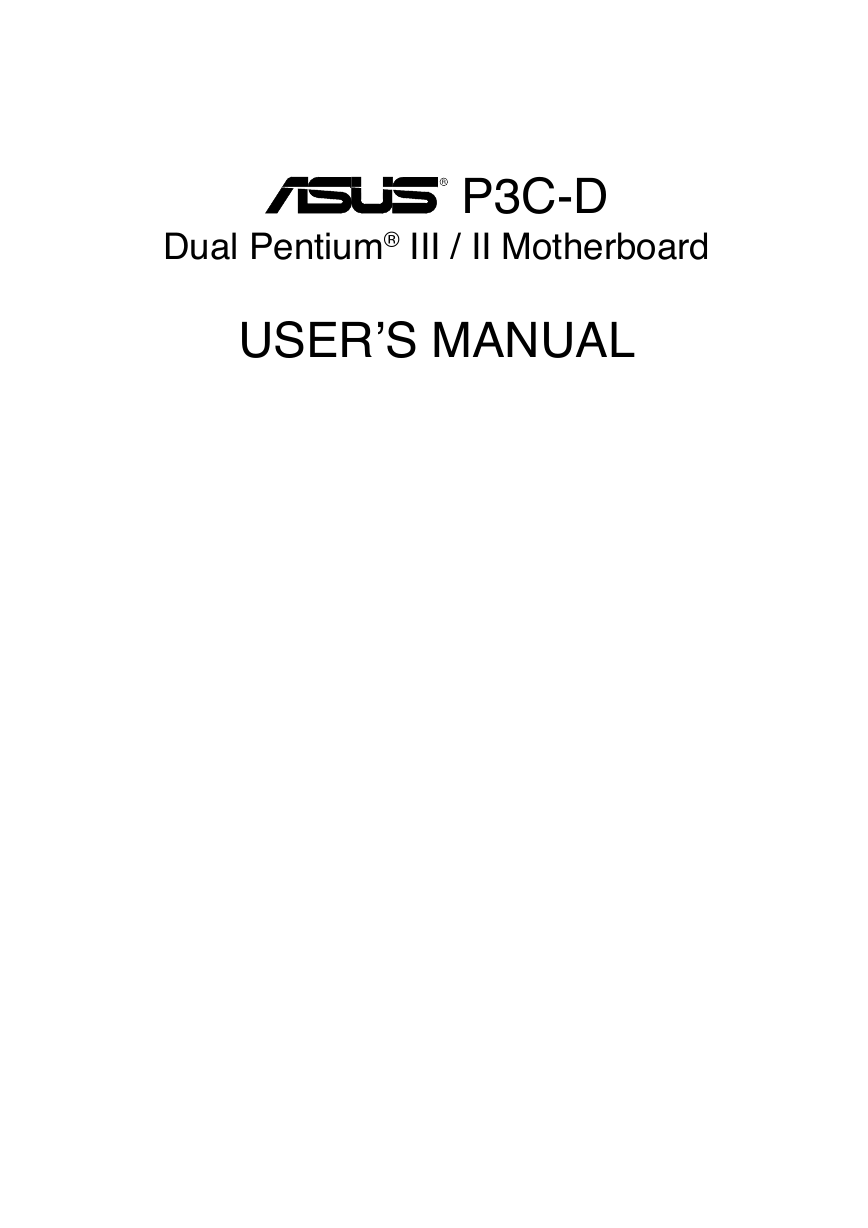
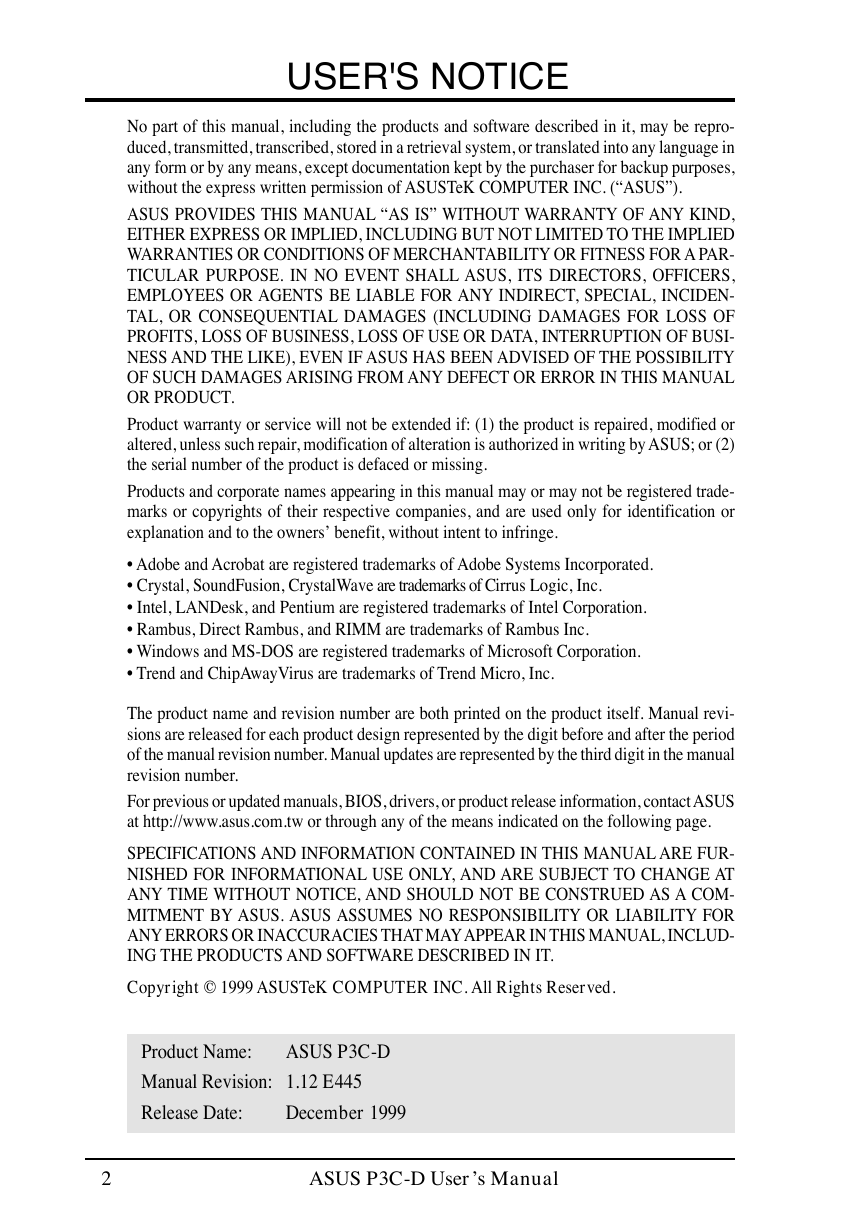
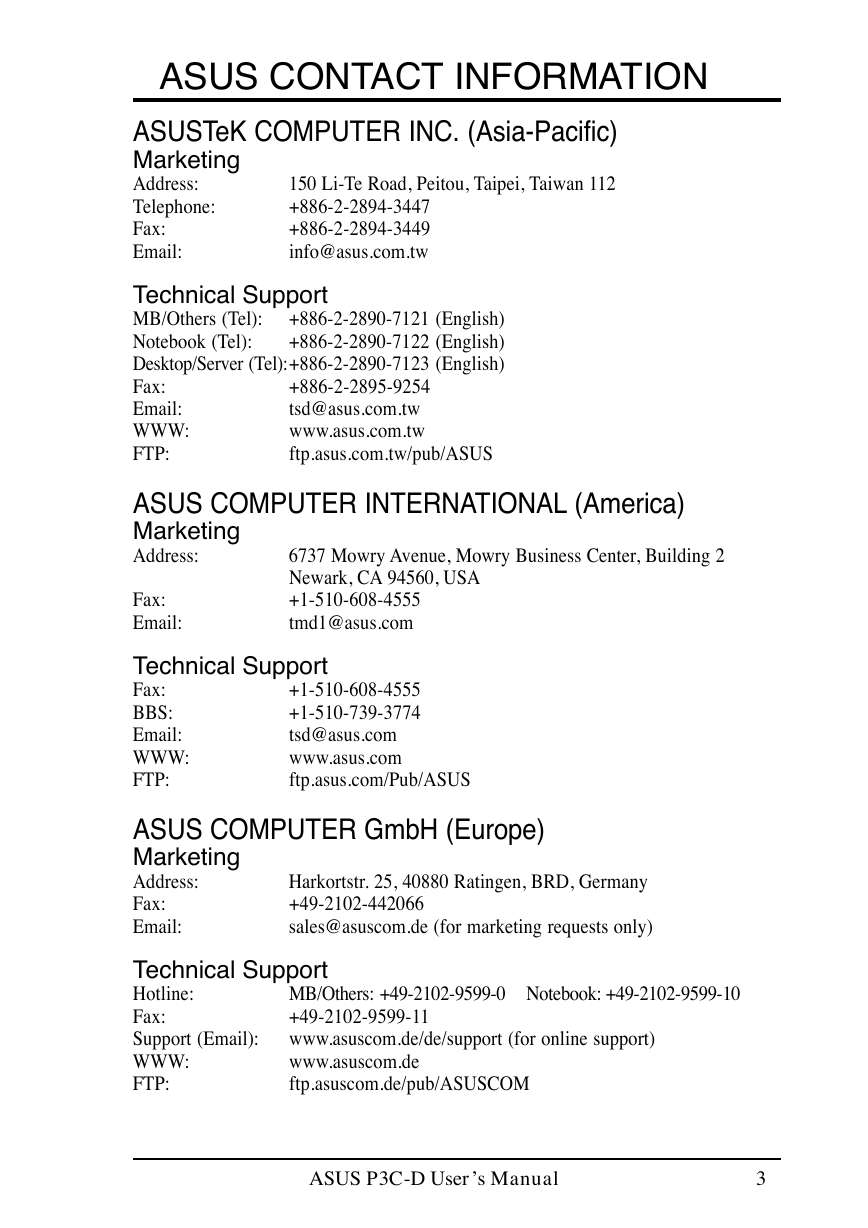
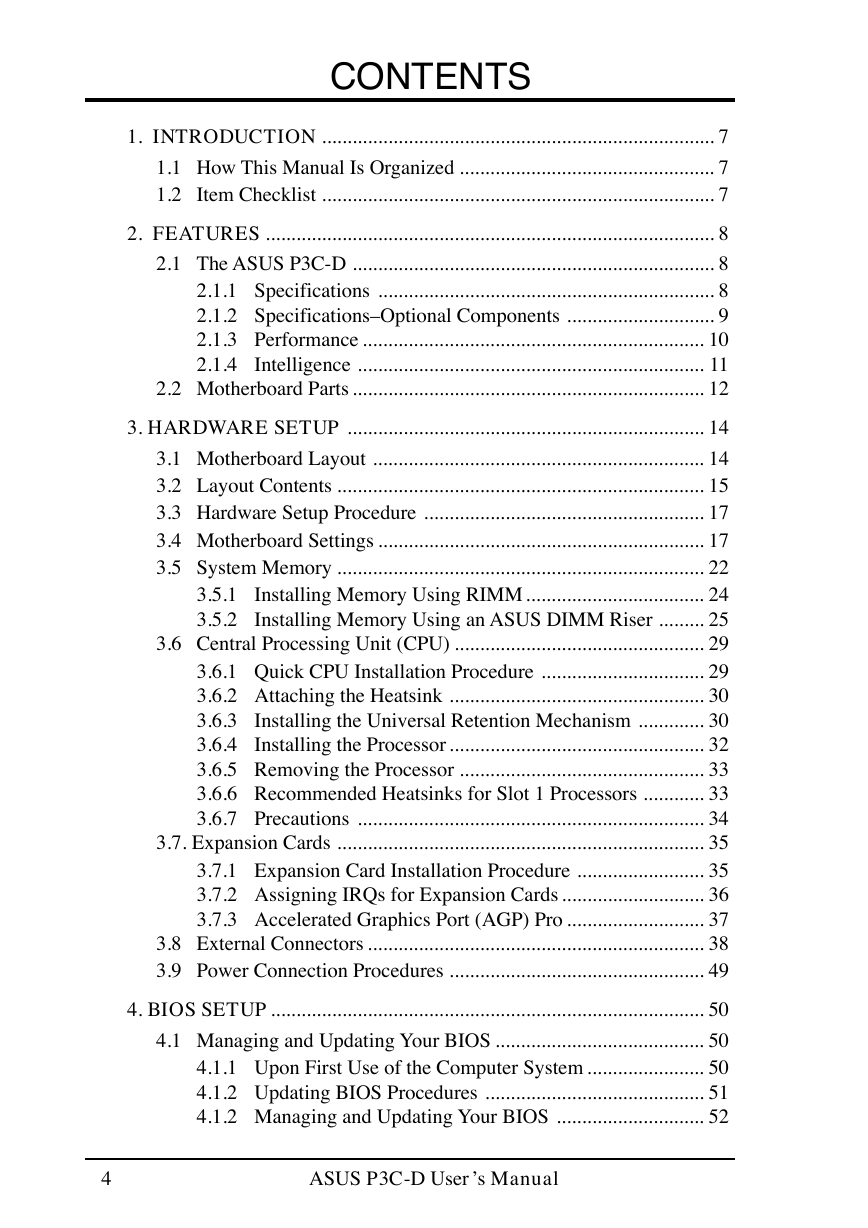
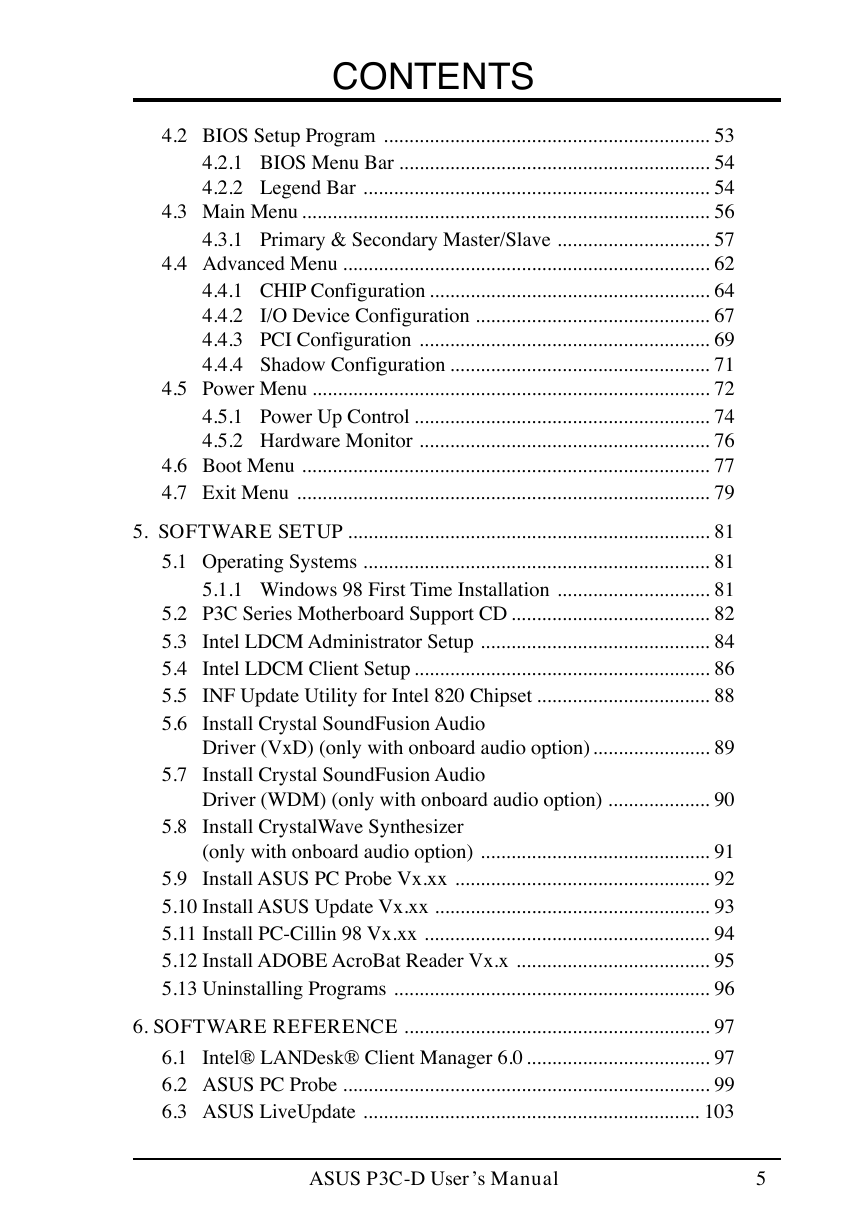
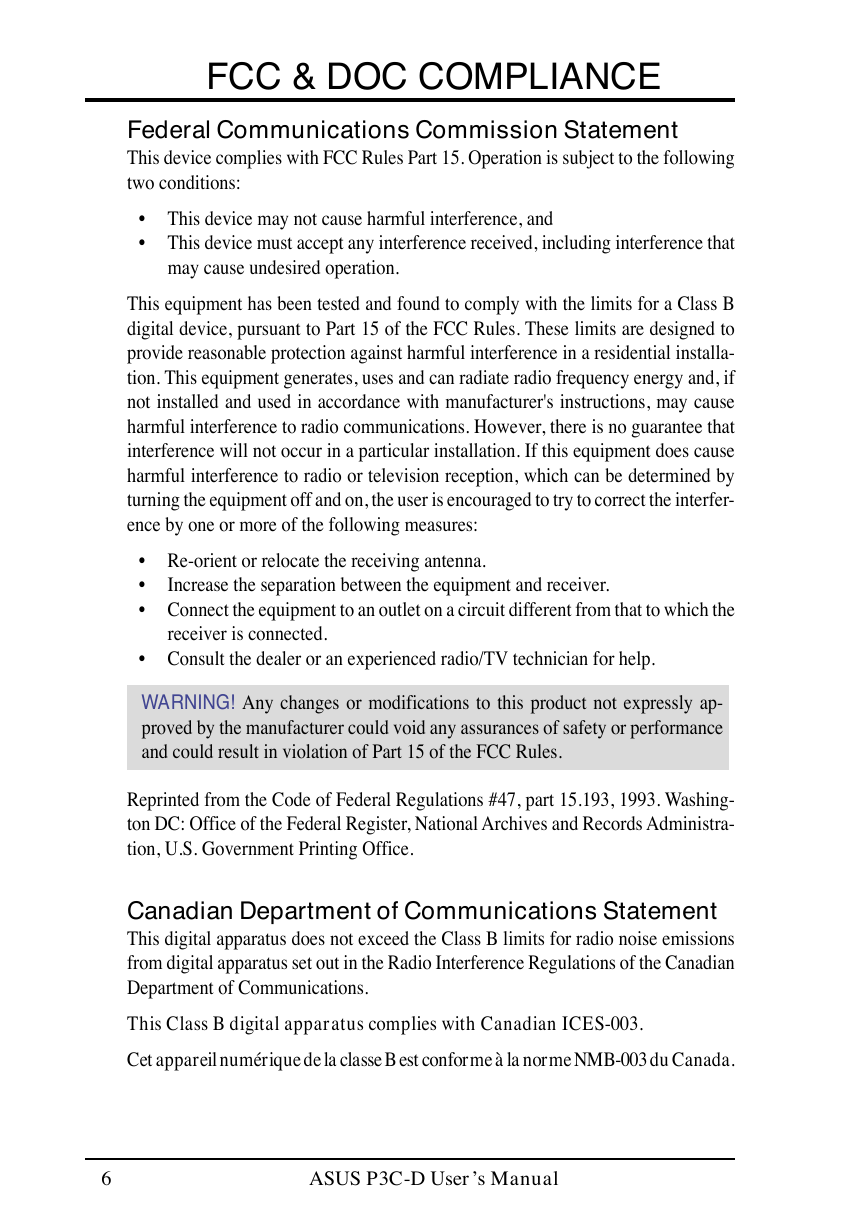

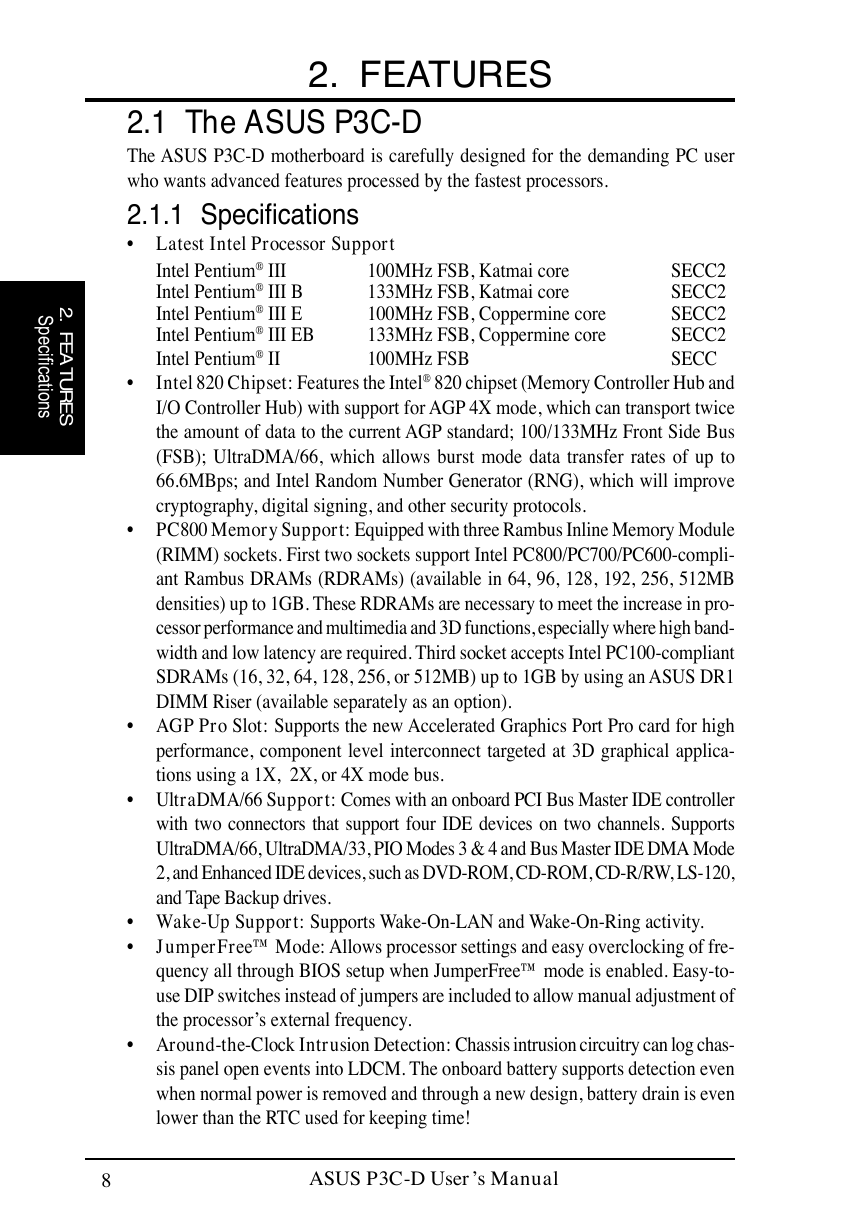








 2023年江西萍乡中考道德与法治真题及答案.doc
2023年江西萍乡中考道德与法治真题及答案.doc 2012年重庆南川中考生物真题及答案.doc
2012年重庆南川中考生物真题及答案.doc 2013年江西师范大学地理学综合及文艺理论基础考研真题.doc
2013年江西师范大学地理学综合及文艺理论基础考研真题.doc 2020年四川甘孜小升初语文真题及答案I卷.doc
2020年四川甘孜小升初语文真题及答案I卷.doc 2020年注册岩土工程师专业基础考试真题及答案.doc
2020年注册岩土工程师专业基础考试真题及答案.doc 2023-2024学年福建省厦门市九年级上学期数学月考试题及答案.doc
2023-2024学年福建省厦门市九年级上学期数学月考试题及答案.doc 2021-2022学年辽宁省沈阳市大东区九年级上学期语文期末试题及答案.doc
2021-2022学年辽宁省沈阳市大东区九年级上学期语文期末试题及答案.doc 2022-2023学年北京东城区初三第一学期物理期末试卷及答案.doc
2022-2023学年北京东城区初三第一学期物理期末试卷及答案.doc 2018上半年江西教师资格初中地理学科知识与教学能力真题及答案.doc
2018上半年江西教师资格初中地理学科知识与教学能力真题及答案.doc 2012年河北国家公务员申论考试真题及答案-省级.doc
2012年河北国家公务员申论考试真题及答案-省级.doc 2020-2021学年江苏省扬州市江都区邵樊片九年级上学期数学第一次质量检测试题及答案.doc
2020-2021学年江苏省扬州市江都区邵樊片九年级上学期数学第一次质量检测试题及答案.doc 2022下半年黑龙江教师资格证中学综合素质真题及答案.doc
2022下半年黑龙江教师资格证中学综合素质真题及答案.doc